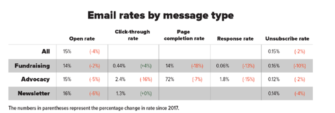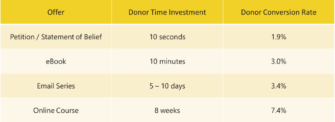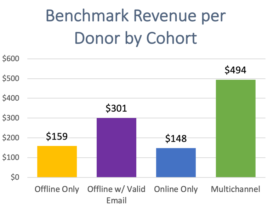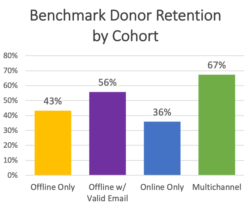Getting More From Digital: Donor Conversion
In an earlier post announcing release of the Blackbaud Institute’s of the 2019 Charitable Giving Report I noted that the growth in online giving was up +6.8% compared to just 1% growth for offline in 2019.
Fearing this statistic might spur some readers (or more likely their board members or CEOs) to rush off and dump direct mail or other channels in favor of online I also noted that, despite this solid growth, digital fundraising accounts for only 8.7% of the total fundraising pie.
To put digital fundraising in perspective compared to the for-profit sector it’s worth noting that despite all the attention given to Amazon and other e-commerce efforts the U.S. Department of Commerce reports that online/e-commerce accounts for only 11% of total U.S. retail sales.
Of course, this does NOT mean we should dismiss digital because it’s only small slice of the bigger fundraising pie. We should not. We must not.
Therefore, unlike the “direct-mail-is-dead” crowd the Agitator’s interest lies in growing, not dismissing digital. Why? Because, if for no other reason so many organizations (not to mention politicians and political hell raisers across the spectrum) depend on it as their principal fundraising channel.
In fact, we’ve had a lot to say about digital. On deliverability – here and here … on Facebook and Google fundraising and audience building – here , here, here and here…Donation pages…here, here, here… and on and on.
Converting Digital Assets to Donors.
If digital fundraising is to reach its full potential a lot more attention needs to be paid to the process of converting digitally acquired audiences into donors. I’m talking about the folks who sign petitions, download information from websites, send their messages to legislators etc. Seemingly interested folks who take some action but fail to translate that action into a fundraising transaction.
Unlike direct mail where the process is well understood and backed by a consistent set of data, digital conversion processes and conversion rates are all over the lot. In the data I’ve reviewed conversion rates range from rang from 0.06% to 1.9%.
In short, there is no “average” in the industry because there is no standard definition, no single source for benchmarking and because relatively few organizations bother to measure, report and share these rates.
Here’s a summary from a top source: M+R’s 2019 Benchmarking Study listing some metrics, including response rates (but not average gifts) from a host of organizations.

Apart from the general stats involving open, click-thru and conversion rates I’m most interested in what content seems to work best. Clearly, one email after the other ain’t the answer or most organizations would be raking it in.
So, I turned to Tim Kachuriak, Chief Innovation and Optimization Officer at
Next After. NextAfter does more disciplined testing and reporting on digital than any other organization in the sector. Just check out the right hand column of their home page, click on what you think needs improvement in your digital program and you’ll see what I mean.
An Uncommon and Important Metric
In a large and rigorous test NextAfter researchers found that the amount of time the donor spends on the offer the higher the response rate.
Here’s the essence of Tim’s and NextAfter’s research on the topic of conversion.
- When it comes to acquiring email subscribers and donors online, content marketing is an effective technique. A good email offer will typically present the prospective donor with an opportunity to get something for free when the give up something of value—usually their name and contact information.
- But when it comes to free online offers, not all offers are created equal. The NextAfter study analyzed the instant new donor conversion rate for new email subscribers that signed up to receive one of four different offer types: advocacy actions (petitions, statements of belief, etc.), eBooks, multi-week email series, and online courses.
- Again, what they discovered is that there is a direct correlation between the time the subscriber engages with the offer and their conversion rate to a donor.
What’s even more interesting is that after additional analysis they found that the instant donor conversion rate holds up even if the subscriber never even engages with the content beyond the point of sign up. So, for example if a new subscriber signs up for a free online course—but never even views the first lesson—they have the same elevated donor conversion rate when they are presented with an opportunity to give immediately after signing up for the course.
According to Tim, what this suggests is that reciprocity is less dependent on what someone actually receives, but more so on what they perceive to be receiving.
The chart below illustrates the different conversion rates for various offers:

Getting More of the Elusive Multi-Channel Donors
It’s also clear from the NextAfter studies that we’d all be better off going beyond a digital-only approach.
It’s no secret that donors who give through multiple channels have greater value to the organization. The chart below represents the average annual donor value by giving channel cohort.

In the chart, Offline-Only donors are donors that give all of their gifts through direct mail. Offline -With Email are donors that give all of their gifts through direct mail, but also have a valid email address on file and receive regular email content (cultivation and solicitations). Online-Only donors give all of their gifts online, and Multichannel donors give at least one gift offline and one gift online in a given fiscal year.
As the chart illustrates, multichannel donors are by far the most valuable with a 211% higher annual value compared to Offline-Only. What’s interesting is that Offline -With Email Donors—even though they never give a gift online, have on average a 90% higher donor value vs. Offline-Only.
And beyond just the annual value of their transactions, retention rates the following year for donors in these giving channel cohorts follow similar trends:

Okay, now here’s the answer to the bajillion dollar question, if multichannel donors are significantly more valuable than any other single channel donor, what acquisition channel produces the greatest number of multichannel donors—offline or online?
Answer: Online Acquired donors.
According to NextAfter, “Online acquired donors are 463% to 14,400% more likely to become a multichannel donor than an offline acquired donor.
The logical question is, why? Here’s how Tim explained it to me. “Well, there a number of small factors, but perhaps the most important factor is something very fundamental and simple. When you acquire a donor let’s say through direct mail, very few donors actually fill out the email field on the direct mail response device.
“I don’t know exactly why and have worked with organizations that have tried all sorts of things to make this more prominent on the reply card without any luck. In fact, in many cases, the only impact of those experiments was actually a decline in donor response rate. So, that means, when you acquire a donor offline, you get very few email addresses, which means your ability to solicit or engage those donors through the digital channel is greatly diminished.
“However, when you acquire a donor online, you get email addresses for 100% of those acquired donors and postal addresses for 100% as well. This means that you now have two rails to run on. You can send postal mail to 100% of your online acquired donors and email to 100% as well. For this reason alone, there may be is significant opportunity for many organizations to shift to a more “Digital First” or “Digital High Priority” acquisition approach.”
Digital Ain’t Dead
Clearly, just as in the case of direct mail, digital fundraising –when conversion processes are thought through and properly executed is far from dead. But it sure could be made more valuable.
AND…just as clearly it will benefit mightily by being married with direct mail and other channels—especially direct mail. [See this Agitator post for the reasons.
An Agitator raise to Tim Kachuriak and the research team at NextAfter for their continual, detailed testing and their willingness to share results.
Plus… a request to Agitator readers to share your digital conversion and multi-channel findings. Thank you.
Roger



Great post Roger and thanks for sharing some of our work via Tim. One additional note here is that the response rate chart in the post is for instant donation conversion only — so the rate that email subscribers by ‘offer’ IMMEDIATELY give. Like immediately on the confirmation page. So the downstream conversion rate (after welcome series, cultivation, asks, etc.) would be even greater. Anywhere from 0.5 to 3 times greater (thanks to Justin Beasley for that tidbit) so a petition you should see something like 3%, eBook around 4.5%, email series in the 5% range and course around 10%. Keep in mind that’s our data and are just rough benchmarks. And you’ll probably need to take a little off if you’re in Canada where we typically have a harder time getting similar rates.
Brady,
Thanks for the clarification. And thanks for all the terrific and detailed information you and the folks at NextAfter share. Much appreciated.
Roger